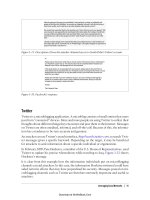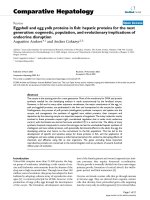Optimizing optimization the next generation of optimization application and theory
Bạn đang xem bản rút gọn của tài liệu. Xem và tải ngay bản đầy đủ của tài liệu tại đây (7.06 MB, 323 trang )
Optimizing Optimization
Quantitative
Finance
Series
Aims and Objectives
●
●
●
●
●
●
Books based on the work of financial market practitioners and academics
Presenting cutting-edge research to the professional/practitioner market
Combining intellectual rigor and practical application
Covering the interaction between mathematical theory and financial practice
To improve portfolio performance, risk management and trading book performance
Covering quantitative techniques
Market
Brokers/Traders; Actuaries; Consultants; Asset Managers; Fund Managers; Regulators; Central Bankers;
Treasury Officials; Technical Analysis; and Academics for Masters in Finance and MBA market.
Series Titles
Economics for Financial Markets
Performance Measurement in Finance
Real R&D Options
Advance Trading Rules, Second Edition
Advances in Portfolio Construction and Implementation
Computational Finance
Linear Factor Models in Finance
Initial Public Offering
Funds of Hedge Funds
Venture Capital in Europe
Forecasting Volatility in the Financial Markets, Third Edition
International Mergers and Acquisitions Activity Since 1990
Corporate Governance and Regulatory Impact on Mergers and Acquisitions
Forecasting Expected Returns in the Financial Markets
The Analytics of Risk Model Validation
Computational Finance Using Cϩϩ and C#
Collectible Investments for the High Net Worth Investor
Series Editor
Dr. Stephen Satchell
Dr. Satchell is the Reader in Financial Econometrics at Trinity College, Cambridge and Visiting
Professor at Birkbeck College, City University Business School and University of Technology, Sydney.
He edits three journals: Journal of Asset Management, Journal of Derivatives and Hedge Funds and
Journal of Risk Model Validation.
Optimizing Optimization
The Next Generation of Optimization
Applications and Theory
Stephen Satchell
AMSTERDAM • BOSTON • HEIDELBERG • LONDON • NEW YORK
OXFORD • PARIS • SAN DIEGO • SAN FRANCISCO • SINGAPORE
SYDNEY • TOKYO
Academic Press is an imprint of Elsevier
Academic Press is an imprint of Elsevier
30 Corporate Drive, Suite 400, Burlington, MA 01803, USA
525 B Street, Suite 1900, San Diego, California 92101-4495, USA
84 Theobald’s Road, London WC1X 8RR, UK
© 2010 Elsevier Limited. All rights reserved.
84 Theobald’s Road, London WC1X 8RR, UK
No part of this publication may be reproduced or transmitted in any form
or by any means, electronic or mechanical, including photocopying, recording, or any
information storage and retrieval system, without permission in writing from the
publisher. Details on how to seek permission, further information about the Publisher’s
permissions policies and our arrangements with organizations such as the Copyright
Clearance Center and the Copyright Licensing Agency, can be found at our website:
www.elsevier.com/permissions.
This book and the individual contributions contained in it are protected under
copyright by the Publisher (other than as may be noted herein).
Notices
Knowledge and best practice in this field are constantly changing. As new research
and experience broaden our understanding, changes in research methods, professional
practices, or medical treatment may become necessary.
Practitioners and researchers must always rely on their own experience and knowledge
in evaluating and using any information, methods, compounds, or experiments described
herein. In using such information or methods they should be mindful of their own safety
and the safety of others, including parties for whom they have a professional responsibility.
To the fullest extent of the law, neither the Publisher nor the authors, contributors, or
editors, assume any liability for any injury and/or damage to persons or property as a
matter of products liability, negligence or otherwise, or from any use or operation of
any methods, products, instructions, or ideas contained in the material herein.
Library of Congress Cataloging-in-Publication Data
British Library Cataloguing-in-Publication Data
A catalogue record for this book is available from the British Library.
ISBN: 978-0-12-374952-9
For information on all Academic Press publications
visit our Web site at www.elsevierdirect.com
Printed in the United States of America
08 09 10 9 8 7 6 5 4 3 2 1
Contents
List of Contributors
xi
Section One Practitioners and Products
1
1 Robust portfolio optimization using second-order
cone programming
Fiona Kolbert and Laurence Wormald
Executive Summary
1.1 Introduction
1.2 Alpha uncertainty
1.3 Constraints on systematic and specific risk
1.4 Constraints on risk using more than one model
1.5 Combining different risk measures
1.6 Fund of funds
1.7 Conclusion
References
2 Novel approaches to portfolio construction: multiple
risk models and multisolution generation
Sebastian Ceria, Francois Margot, Anthony Renshaw and
Anureet Saxena
Executive Summary
2.1 Introduction
2.2 Portfolio construction using multiple risk models
2.2.1 Out-of-sample results
2.2.2 Discussion and conclusions
2.3 Multisolution generation
2.3.1 Constraint elasticity
2.3.2 Intractable metrics
2.4 Conclusions
References
3 Optimal solutions for optimization in practice
Daryl Roxburgh, Katja Scherer and Tim Matthews
Executive Summary
3.1 Introduction
3.1.1 BITA Star(™)
3.1.2 BITA Monitor(™)
3
3
3
4
6
12
16
18
22
22
23
23
23
25
33
34
35
39
41
51
52
53
53
53
54
54
vi
Contents
3.2
3.3
3.4
3.5
3.6
3.7
3.1.3 BITA Curve(™)
3.1.4 BITA Optimizer(™)
Portfolio optimization
3.2.1 The need for optimization
3.2.2 Applications of portfolio optimization
3.2.3 Program trading
3.2.4 Long–short portfolio construction
3.2.5 Active quant management
3.2.6 Asset allocation
3.2.7 Index tracking
Mean–variance optimization
3.3.1 A technical overview
3.3.2 The BITA optimizer—functional summary
Robust optimization
3.4.1 Background
3.4.2 Introduction
3.4.3 Reformulation of mean–variance optimization
3.4.4 BITA Robust applications to controlling FE
3.4.5 FE constraints
3.4.6 Preliminary results
3.4.7 Mean forecast intervals
3.4.8 Explicit risk budgeting
BITA GLO(™)-Gain/loss optimization
3.5.1 Introduction
3.5.2 Omega and GLO
3.5.3 Choice of inputs
3.5.4 Analysis and comparison
3.5.5 Maximum holding ϭ 100%
3.5.6 Adding 25% investment constraint
3.5.7 Down-trimming of emerging market returns
3.5.8 Squared losses
3.5.9 Conclusions
Combined optimizations
3.6.1 Introduction
3.6.2 Discussion
3.6.3 The model
3.6.4 Incorporation of alpha and risk model information
Practical applications: charities and endowments
3.7.1 Introduction
3.7.2 Why endowments matter
3.7.3 Managing endowments
3.7.4 The specification
3.7.5 Trustees’ attitude to risk
3.7.6 Decision making under uncertainty
3.7.7 Practical implications of risk aversion
54
54
55
55
55
55
55
56
56
56
56
56
57
58
58
58
59
61
61
62
65
65
66
66
67
68
69
70
70
70
71
72
73
73
74
75
76
78
78
78
79
80
82
83
84
Contents
3.8 Bespoke optimization—putting theory into practice
3.8.1 Request: produce optimal portfolio with exactly 50 long
and 50 short holdings
3.8.2 Request: how to optimize in the absence
of forecast returns
3.9 Conclusions
Appendix A: BITA Robust optimization
Appendix B: BITA GLO
References
4 The Windham Portfolio Advisor
Mark Kritzman
Executive Summary
4.1 Introduction
4.2 Multigoal optimization
4.2.1 The problem
4.2.2 The WPA solution
4.2.3 Summary
4.3 Within-horizon risk measurement
4.3.1 The problem
4.3.2 The WPA solution
4.4 Risk regimes
4.4.1 The problem
4.4.2 The WPA solution
4.4.3 Summary
4.5 Full-scale optimization
4.5.1 The problem
4.5.2 The WPA solution
4.5.3 Summary
Appendix—WPA features
References
Section Two Theory
5 Modeling, estimation, and optimization of equity
portfolios with heavy-tailed distributions
Almira Biglova, Sergio Ortobelli, Svetlozar Rachev and
Frank J. Fabozzi
Executive Summary
5.1 Introduction
5.2 Empirical evidence from the Dow Jones Industrial
Average components
5.3 Generation of scenarios consistent with empirical evidence
5.3.1 The portfolio dimensionality problem
5.3.2 Generation of return scenarios
vii
86
86
86
87
88
89
90
93
93
93
94
94
94
97
97
97
97
101
101
101
104
104
104
104
107
111
113
115
117
117
117
119
121
121
126
viii
Contents
5.4 The portfolio selection problem
5.4.1 Review of performance ratios
5.4.2 An empirical comparison among portfolio strategies
5.5 Concluding remarks
References
130
132
134
136
140
6 Staying ahead on downside risk
Giuliano De Rossi
Executive Summary
6.1 Introduction
6.2 Measuring downside risk: VaR and EVaR
6.2.1 Definition and properties
6.2.2 Modeling EVaR dynamically
6.3 The asset allocation problem
6.4 Empirical illustration
6.5 Conclusion
References
143
7 Optimization and portfolio selection
Hal Forsey and Frank Sortino
Executive Summary
7.1 Introduction
7.2 Part 1: The Forsey–Sortino Optimizer
7.2.1 Basic assumptions
7.2.2 Optimize or measure performance
7.3 Part 2: The DTR optimizer
Appendix: Formal definitions and procedures
References
161
8 Computing optimal mean/downside risk
frontiers: the role of ellipticity
Tony Hall and Stephen E. Satchell
Executive Summary
8.1 Introduction
8.2 Main proposition
8.3 The case of two assets
8.4 Conic results
8.5 Simulation methodology
8.6 Conclusion
References
9 Portfolio optimization with “Threshold
Accepting”: a practical guide
Manfred Gilli and Enrico Schumann
Executive Summary
143
143
145
145
147
150
153
158
159
161
161
162
162
165
167
171
177
179
179
179
180
184
190
194
198
198
201
201
Contents
9.1 Introduction
9.2 Portfolio optimization problems
9.2.1 Risk and reward
9.2.2 The problem summarized
9.3 Threshold accepting
9.3.1 The algorithm
9.3.2 Implementation
9.4 Stochastics
9.5 Diagnostics
9.5.1 Benchmarking the algorithm
9.5.2 Arbitrage opportunities
9.5.3 Degenerate objective functions
9.5.4 The neighborhood and the thresholds
9.6 Conclusion
Acknowledgment
References
10 Some properties of averaging simulated
optimization methods
John Knight and Stephen E. Satchell
Executive Summary
10.1 Section 1
10.2 Section 2
10.3 Remark 1
10.4 Section 3: Finite sample properties of estimators of
alpha and tracking error
10.5 Remark 2
10.6 Remark 3
10.7 Section 4
10.8 Section 5: General linear restrictions
10.9 Section 6
10.10 Section 7: Conclusion
Acknowledgment
References
11 Heuristic portfolio optimization: Bayesian updating
with the Johnson family of distributions
Richard Louth
Executive Summary
11.1 Introduction
11.2 A brief history of portfolio optimization
11.3 The Johnson family
11.3.1 Basic properties
11.3.2 Density estimation
ix
201
204
204
209
210
210
211
215
218
218
218
219
219
220
221
221
225
225
225
226
229
230
235
236
236
238
241
244
244
245
247
247
247
248
251
251
254
x
Contents
11.3.3 Simulating Johnson random variates
11.4 The portfolio optimization algorithm
11.4.1 The maximization problem
11.4.2 The threshold acceptance algorithm
11.5 Data reweighting
11.6 Alpha information
11.7 Empirical application
11.7.1 The decay factor, ρ
11.7.2 The coefficient of disappointment aversion, A
11.7.3 The importance of non-Gaussianity
11.8 Conclusion
11.9 Appendix
References
12 More than you ever wanted to know about
conditional value at risk optimization
Bernd Scherer
Executive Summary
12.1 Introduction: Risk measures and their axiomatic foundations
12.2 A simple algorithm for CVaR optimization
12.3 Downside risk measures
12.3.1 Do we need downside risk measures?
12.3.2 How much momentum investing is in a downside
risk measure?
12.3.3 Will downside risk measures lead to
“under-diversification”?
12.4 Scenario generation I: The impact of estimation and
approximation error
12.4.1 Estimation error
12.4.2 Approximation error
12.5 Scenario generation II: Conditional versus
unconditional risk measures
12.6 Axiomatic difficulties: Who has CVaR preferences anyway?
12.7 Conclusion
Acknowledgment
References
Index
256
257
257
260
261
262
265
266
268
268
271
272
278
283
283
283
285
288
288
288
290
292
292
293
295
296
298
298
298
301
List of Contributors
Almira Biglova holds a PhD in mathematical and empirical finance and is currently a Risk Controller at DZ Bank International in Luxembourg. She held
previous positions as a research assistant in the Department of Econometrics,
Statistics, and Mathematical Finance at the University of Karlsruhe in Germany,
an Assistant Professor in the Department of Mathematics and Cybernetics on
the Faculty of Informatics at Technical University of Ufa in Russia, and a financial specialist in the Department of Financial Management at Moscow Credit
Bank in Russia. She specializes in mathematical modeling and numerical methods. Dr. Biglova has published more than 30 research papers in finance.
Sebastian Ceria is CEO of Axioma, Inc. Before founding Axioma, Ceria was
an Associate Professor of Decision, Risk, and Operations at Columbia Business
School from 1993 to 1998. He was honored with the prestigious Career Award
for Operations Research from the National Science Foundation, and recognized as the “best core teacher” by his students and the school. Ceria completed his PhD in operations research at Carnegie Mellon University’s Graduate
School of Industrial Administration.
Giuliano De Rossi is a quantitative analyst in the Equities Quantitative
Research Group at UBS, which he joined in 2006. Between 2004 and 2006,
he was a Fellow and Lecturer in economics at Christ’s College, Cambridge
University, and a part-time consultant to London-based hedge funds. His academic research focused on signal extraction and its application to financial
time series data. Giuliano holds an MSc in economics from the London School
of Economics and a PhD in economics from Cambridge University.
Frank J. Fabozzi is Professor in the Practice of Finance and Becton Fellow at
the Yale School of Management. He is an Affiliated Professor at the University
of Karlsruhe (Germany) Institut für Statistik, Ökonometrie und Mathematische
Finanzwirtschaft (Institute of Statistics, Econometrics and Mathematical
Finance). He earned a doctorate in economics from the City University of
New York in 1972. In 2002, he was inducted into the Fixed Income Analysts
Society’s Hall of Fame and is the 2007 recipient of the C. Stewart Sheppard
Award given by the CFA Institute. He has served as the editor of the Journal of
Portfolio Management since 1985.
xii
List of Contributors
Hal Forsey earned a PhD in mathematics at the University of Southern
California and a masters in operations research from U.C. Berkeley. He is
Professor of Mathematics Emeritus at San Francisco State University and has
worked closely with Dr. Frank Sortino for over 25 years. Dr. Forsey wrote the
source code for all of the models developed at the Pension Research Institute,
including the software on the CD in the book Managing Downside Risk. Hal
co-authored many articles with Dr. Sortino and his wide consulting experience
in applied mathematics has been invaluable to the SIA executive team.
Manfred Gilli is Professor emeritus at the Department of Econometrics at the
University of Geneva, Switzerland, where he taught numerical methods in economics and finance. His main research interests include the numerical solution
of large and sparse systems of equations, parallel computing, heuristic optimization techniques, and numerical methods for pricing financial instruments.
He is a member of the advisory board of Computational Statistics and Data
Analysis and member of the editorial boards of Computational Economics
and the Springer book series on Advances in Computational Economics and
Advances in Computational Management Science.
A. D. Hall holds a PhD in econometrics (London School of Economics, 1976).
He has taught econometrics at the Australian National University and the
University of California, San Diego (both recognized internationally as leading institutions for this discipline) and finance at the School of Business, Bond
University and the University of Technology, Sydney. He has publications in a
number of the leading international journals in economics and econometrics,
including The Review of Economics and Statistics, The Review of Economic
Studies, The International Economic Review, The Journal of Econometrics,
Econometric Theory, Econometric Reviews, The Journal of Business and
Economic Statistics, Biometrika, and The Journal of Time Series Analysis. His
research interests cover all aspects of financial econometrics, with a special
interest in modeling the term structure of interest rates. Dr. Hall is currently
the Head of the School of Finance and Economics.
John Knight is Professor of Economics at the University of Western Ontario.
His research interests are in theoretical and financial econometrics, areas in
which he has published extensively as well as supervised numerous doctoral
dissertations.
Fiona Kolbert is a member of the Research Group at SunGard APT where she
has worked since 1998. She is the lead researcher and developer of their optimizer product.
Mark Kritzman is President and CEO of Windham Capital Management, LLC,
and a Senior Partner of State Street Associates. He teaches financial engineering
at MIT’s Sloan School and serves on the boards of the Institute for Quantitative
List of Contributors
xiii
Research in Finance and The Investment Fund for Foundations. Mr. Kritzman
has written numerous articles and is the author of six books, including Puzzles
of Finance and The Portable Financial Analyst. He has an MBA with distinction from New York University and a CFA designation.
Richard Louth is a PhD student at the University of Cambridge, a Teaching
Fellow at the Faculty of Economics, and a Preceptor Corpus Christi College.
He holds a first-class honors degree and an MPhil with distinction from said
university. His research interests include portfolio optimization, dependence
modeling, and forecasting methods.
Sergio Ortobelli Lozza is Associate Professor at “Lorenzo Mascheroni”
Department of University of Bergamo (Italy), Laurea in Mathematics at University
of Milan, Italy (1994), PhD in mathematical finance, University of Bergamo, Italy
(1999), and Researcher (1999–2002) at the University of Calabria, Italy. His
research activity is primarily focused on the application of different distributional
approaches to portfolio theory, risk management, and option theory.
Francois Margot is an Associate Professor at the Tepper School of Business of
Carnegie Mellon University and Senior Associate Researcher at Axioma. He
has written numerous papers on mixed-integer linear and nonlinear optimization. He has a Mathematical Engineer Diploma and a PhD from the Ecole
Polytechnique Federale of Lausanne (Switzerland), and prior to joining Axioma
on leave from Carnegie Mellon University, he has held academic positions at
the University of British Columbia, Michigan Technological University, and
University of Kentucky, and was an Academic Visitor at the IBM T.J. Watson
Research Center. He lives in Pittsburgh and Atlanta.
Tim Matthews has almost 20 years, experience working in the risk, performance, and quantitative analytics arenas, primarily within the European investment management community. His roles have included senior positions in
business development, client service, and research and product development at
firms including QUANTEC, Thomson Financial, and most recently BITA Risk
Solutions. Recent roles include Director of Business Development at Thomson
Financial responsible for the distribution and service of their Quantitative
Analytics (TQA) platforms successfully establishing a significant footprint in
the EMEA region. Tim holds masters degrees in applied statistics and stochastic
modeling from Birkbeck, University of London, and in Electronic Engineering
from Southampton University. He is an Associate (ASIP) of the CFA Society of
the UK.
Svetlozar Rachev was a co-founder and President of BRAVO Risk Management
Group, originator of the Cognity methodology, which was acquired by FinAnalytica, where he serves as Chief Scientist. Rachev holds Chair-Professorship
in Statistics, Econometrics, and Mathematical Finance at University of Karlsruhe,
xiv
List of Contributors
and is the author of 12 books and over 300 published articles on finance, econometrics, statistics, and actuarial science. At University of California at Santa
Barbara, he founded the PhD program in mathematical and empirical finance.
Rachev holds PhD (1979) and Doctor of Science (1986) degrees from Moscow
University and Russian Academy of Sciences. Rachev’s scientific work lies at the
core of Cognity’s newer and more accurate methodologies in risk management
and portfolio analysis.
Anthony Renshaw is Axioma Director of Applied Research. He has written
numerous articles and white papers detailing real-world results of various portfolio construction strategies. He has an AB in applied mathematics from Harvard and a PhD in mechanical engineering from U.C. Berkeley.
Prior to joining Axioma, he worked on Space Station Freedom, designed
washing machines and X-ray tubes at General Electric’s Corporate Research
and Development Center, and taught mechanical engineering as an Associate
Professor at Columbia University. He holds seven US patents and has over 30
refereed publications. He lives in New York City and Hawaii.
Daryl Roxburgh is Head of BITA Risk Solutions, the London- and New Yorkbased portfolio construction and risk solutions provider. He specializes in
portfolio construction and risk analysis solutions for the quantitative, institutional, and private banking markets. He is an avid antique car collector and
has advised on this topic.
Stephen Satchell is a Fellow of Trinity College, Cambridge and Visiting
Professor at Birkbeck College, City University Business School and University
of Technology, Sydney. He provides consulting for a range of financial institutions in the broad area of quantitative finance. He has edited or authored
over 20 books in finance. Dr. Satchell is the Editor of three journals: Journal
of Asset Management, Journal of Derivatives and Hedge Funds and Journal of
Risk Model Validation.
Anureet Saxena is an Associate Researcher at Axioma Inc. His research concerns mixed-integer linear and nonlinear programming. He holds a PhD
and masters in industrial administration from Tepper School of Business,
Carnegie Mellon University, and BTech in computer science and engineering from Indian Institute of Technology, Bombay. He was awarded the 2008
Gerald L. Thompson award for best dissertation in management science. He
is the numero uno winner of the Egon Balas award for best student paper,
gold medalist at a national level physics competition, and a national talent
scholar. He has authored papers in leading mathematical programming journals and has delivered more than a dozen invited talks at various international
conferences.
List of Contributors
xv
Bernd Scherer is Managing Director at Morgan Stanley Investment Management
and Visiting Professor at Birkbeck College. Bernd published in the Journal of
Economics and Statistics, Journal of Money Banking and Finance, Financial
Analysts Journal, Journal of Portfolio Management, Journal of Investment
Management, Risk, Journal of Applied Corporate Finance, Journal of Asset
Management, etc. He received masters degrees in economics from the University of
Augsburg and the University of London and a PhD from the University of Giessen.
Katja Scherer is a Quantitative Research Analyst at BITA Risk, where she
is focusing on portfolio optimization strategies and quantitative consulting projects. Previously, she was a Client Relationship Manager at Deutsche
Asset Management, Frankfurt. Mrs. Scherer holds a BA degree from the
University of Hagen and an MSc degree in economics from the University of
Witten/Herdecke, both Germany. She also received a Finance Certificate in the
Computational Finance Program at Carnegie Mellon University, New York.
Enrico Schumann is a Research Fellow with the Marie Curie RTN
“Computational Optimization Methods in Statistics, Econometrics and
Finance” (COMISEF) and a PhD candidate at the University of Geneva,
Switzerland. He holds a BA in economics and law and an MSc in economics
from the University of Erfurt, Germany, and has worked for several years as a
Risk Manager with a public sector bank in Germany. His academic and professional interests include financial optimization, in particular portfolio selection,
and computationally intensive methods in statistics and econometrics.
Frank A. Sortino, Chairman and Chief Investment Officer, is Professor of
Finance emeritus at San Francisco State University. He founded the Pension
Research Institute in 1981 as a nonprofit organization, focusing on problems facing fiduciaries. When Dr. Sortino retired from teaching in 1997, the
University authorized PRI’s privatization as a for-profit think tank.
PRI, founded in 1981, has conducted research projects with firms such as
Shell Oil Pension Funds, the Netherlands; Fortis, the Netherlands; Manulife,
Toronto, Canada; Twentieth Century Funds, City & County of San Francisco
Retirement System, Marin County Retirement System, and The California State
Teachers Retirement System. The results of this research have been published
in many leading financial journals and magazines.
Prior to teaching, Dr. Sortino was in the investment business for more than
a decade and was a partner of a New York Stock Exchange firm and Senior
VP of an investment advisory firm with over $1 billion in assets. He is known
internationally for his published research on measuring and managing investment risk and the widely used Sortino ratio. Dr. Sortino serves on the Board of
Directors of the Foundation for Fiduciary Studies and writes a quarterly analysis of mutual funds for Pensions & Investments magazine. Dr. Sortino earned an
MBA from U.C. Berkeley and a PhD in finance from the University of Oregon.
xvi
List of Contributors
Laurence Wormald is Head of Research at SunGard APT where he has worked
since July 2008. Previously he had served as Chief Risk Officer for a business
unit of Deutsche Bank in London, and before that as Research Director for
several other providers of risk analytics to institutional investors. Laurence has
also worked over the last 15 years as a consultant to the Bank for International
Settlements, the European Central Bank, and the Bank of England. He is currently Chairman of the City Associates Board of the Centre for Computational
Finance and Economic Agents (CCFEA) at Essex University.
Section One
Practitioners and Products
This page intentionally left blank
1 Robust portfolio optimization using
second-order cone programming
Fiona Kolbert and Laurence Wormald
Executive Summary
Optimization maintains its importance within portfolio management, despite
many criticisms of the Markowitz approach, because modern algorithmic
approaches are able to provide solutions to much more wide-ranging optimization
problems than the classical mean–variance case. By setting up problems with
more general constraints and more flexible objective functions, investors can
model investment realities in a way that was not available to the first generation
of users of risk models.
In this chapter, we review the use of second-order cone programming to handle
a number of economically important optimization problems involving:
●
●
●
●
●
Alpha uncertainty
Constraints on systematic and specific risks
Fund of funds with multiple active risk constraints
Constraints on risk using more than one risk model
Combining different risk measures
1.1 Introduction
Despite an almost-continuous criticism of mathematical optimization as a
method of constructing investment portfolios since it was first proposed, there
are an ever-increasing number of practitioners of this method using it to manage more and more assets. Given the fact that the problems associated with the
Markowitz approach are so well known and so widely acknowledged, why is
it that portfolio optimization remains popular with well-informed investment
professionals?
The answer lies in the fact that modern algorithmic approaches are able to provide solutions to much more wide-ranging optimization problems than the classical mean–variance case. By setting up problems with more general constraints
and more flexible objective functions, investors can model investment realities in
a way that was not available to the first generation of users of risk models.
In particular, the methods of cone programming allow efficient solutions
to problems that involve more than one quadratic constraint, more than one
© 2009
2010 Elsevier Limited. All rights reserved.
Doi:10.1016/B978-0-12-374952-9.00001-4.
4
Optimizing Optimization
quadratic term within the utility function, and more than one benchmark. In
this way, investors can go about finding solutions that are robust against the
failure of a number of simplifying assumptions that had previously been seen
as fatally compromising the mean–variance optimization approach.
In this chapter, we consider a number of economically important optimization problems that can be solved efficiently by means of second-order cone
programming (SOCP) techniques. In each case, we demonstrate by means
of fully worked examples the intuitive improvement to the investor that can
be obtained by making use of SOCP, and in doing so we hope to focus the
discussion of the value of portfolio optimization where it should be on the
proper definition of utility and the quality of the underlying alpha and risk
models.
1.2 Alpha uncertainty
The standard mean–variance portfolio optimization approach assumes that the
alphas are known and given by some vector α. The problem with this is that
generally the alpha predictions are not known with certainty—an investor can
estimate alphas but clearly cannot be certain that their predictions will be correct. However, when the alpha predictions are subsequently used in an optimization, the optimizer will treat the alphas as being certain and may choose a
solution that places unjustified emphasis on those assets that have particularly
large alpha predictions.
Attempts to compensate for this in the standard quadratic programming
approach include just reducing alphas that look too large to give more conservative estimates and imposing constraints such as maximum asset weight
and sector weight constraints to try and prevent any individual alpha estimate
having too large an impact. However, none of these methods directly address
the issue and these approaches can lead to suboptimal results. A better way of
dealing with the problem is to use SOCP to include uncertainty information in
the optimization process.
If the alphas are assumed to follow a normal distribution with mean α* and
known covariance matrix of estimation errors Ω, then we can define an elliptical confidence region around the mean estimated alphas as:
(α Ϫ α*)T ΩϪ1 (α − α*) Յ k2
There are then several ways of setting up the robust optimization problem;
the one we consider is to maximize the worst-case return for the given confidence region, subject to a constraint on the mean portfolio return, αp. If w is
the vector of portfolio weights, the problem is:
Maximize (Min(w Tα) Ϫ portfolio variance)
Robust portfolio optimization using second-order cone programming
5
subject to
(α Ϫ α*)T ΩϪ1 (α Ϫ α*) Յ k2
α*T w ϭ αp
eT w ϭ 1
w Ն0
This can be written as an SOCP problem by introducing an extra variable,
αu (for more details on the derivation, see Scherer (2007)):
Maximize (w T α* Ϫ kαu Ϫ portfolio variance)
subject to
w T Ωw Յ αu2
α*T w ϭ α p
eT w ϭ 1
w Ն0
Figure 1.1 shows the standard mean–variance frontier and the frontier generated including the alpha uncertainty term (“Alpha Uncertainty Frontier”).
The example has a 500-asset universe and no benchmark and the mean portfolio alpha is constrained to various values between the mean portfolio alpha
found for the minimum variance portfolio (assuming no alpha uncertainty) and
0.9. The size of the confidence region around the mean estimated alphas (i.e.,
the value of k) is increased as the constraint on the mean portfolio alpha is
increased. The covariance matrix of estimation errors Ω is assumed to be the
individual volatilities of the assets calculated using a SunGard APT risk model.
The portfolio variance is also calculated using a SunGard APT risk model.
Some extensions to this, e.g., the use of a benchmark and active portfolio
return, are straightforward.
The key questions to making practical use of alpha uncertainty are the specification of the covariance matrix of estimation errors Ω and the size of the
confidence region around the mean estimated alphas (the value of k). This will
depend on the alpha generation process used by the practitioner and, as for
the alpha generation process, it is suggested that backtesting be used to aid in
the choice of appropriate covariance matrices Ω and confidence region sizes k.
From a practical point of view, for reasonably sized problems, it is helpful if
the covariance matrix Ω is either diagonal or a factor model is used.
6
Optimizing Optimization
0.95
0.9
Mean portfolio alpha
0.85
0.8
0.75
0.7
0.65
0.6
0.55
0.5
0.45
6
6.5
7
7.5
8
Portfolio volatility
Alpha uncertainty frontier
MV frontier
Figure 1.1 Alpha uncertainty efficient frontiers.
1.3 Constraints on systematic and specific risk
In most factor-based risk models, the risk of a portfolio can be split into a part
coming from systematic sources and a part specific to the individual assets
within the portfolio (the residual risk). In some cases, portfolio managers are
willing to take on extra risk or sacrifice alpha in order to ensure that the systematic or specific risk is below a certain level.
A heuristic way of achieving a constraint on systematic risk in a standard
quadratic programming problem format is to linearly constrain the portfolio
factor loadings. This works well in the case where no systematic risk is the
requirement, e.g., in some hedge funds that want to be market neutral, but is
problematic in other cases because there is the question of how to split the systematic risk restrictions between the different factors. In a prespecified factor
model, it may be possible to have some idea about how to constrain the risk
on individual named factors, but it is generally not possible to know how to do
this in a statistical factor model. This means that in most cases, it is necessary
to use SOCP to impose a constraint on either the systematic or specific risk.
In the SunGard APT risk model, the portfolio variance can be written as:
w T BT B w ϩ w T ∑ w
Robust portfolio optimization using second-order cone programming
7
where
w ϭ n ϫ 1 vector of portfolio weights
B ϭ c ϫ n matrix of component (factor) loadings
Σ ϭ n ϫ n diagonal matrix of specific (residual) variances
The systematic risk of the portfolio is then given by:
Systematic risk of portfolio ϭ √ (w T BT B w)
and the specific risk of the portfolio by:
Specific risk of portfolio ϭ Ί (w T ∑ w)
The portfolio optimization problem with a constraint on the systematic risk
(σsys) is then given by the SOCP problem:
Minimize (w T BT B w ϩ w T ∑ w)
subject to
w T BT B w Յ σsys2
α*T w ϭ αp
eT w ϭ 1
w Ն0
where
α* ϭ n ϫ 1 vector of estimated asset alphas
αp ϭ portfolio return
One point to note on the implementation is that the BTB matrix is never calculated directly (this would be an n ϫ n matrix, so could become very large when
used in a realistic-sized problem). Instead, extra variables bi are introduced, one
per factor, and constrained to be equal to the portfolio factor loading:
bi ϭ (Bw)i ,i ϭ 1⋅⋅⋅ c
This then gives the following formulation for the above problem of constraining the systematic risk:
Minimize(bT b ϩ w T ∑ w)
8
Optimizing Optimization
subject to
bT b Յ σsys2
α*T w ϭ αp
eT w ϭ 1
b ϭ Bw
w Ն0
Similarly, the problem with a constraint on the specific risk (σspe) is given by:
Minimize (bT b ϩ w T ∑ w)
subject to
w T ∑ w Յ σspe2
α*T w ϭ αp
eT w ϭ 1
b ϭ Bw
w Ն0
Figure 1.2 shows the standard mean–variance frontier and the frontiers generated with constraints on the specific risk of 2% and 3%, and on the systematic risk of 5%. The example has a 500-asset universe and no benchmark
and the portfolio alpha is constrained to various values between the portfolio
alpha found for the minimum variance portfolio and 0.9. (For the 5% constraint on the systematic risk, it was not possible to find a feasible solution
with a portfolio alpha of 0.9.) Figure 1.3 shows the systematic portfolio volatilities and Figure 1.4 shows the specific portfolio volatilities for the same set
of optimizations.
Constraints on systematic or specific volatility can be combined with the
alpha uncertainty described in the previous section. The resulting frontiers can
be seen in Figures 1.5–1.7 (the specific 3% constraint frontier is not shown
because this coincides with the Alpha Uncertainty Frontier for all but the first
point).
The shape of the specific risk frontier for the alpha uncertainty frontier (see
Figure 1.7) is unusual. This is due to a combination of increasing the emphasis on the alpha uncertainty as the constraint on the mean portfolio alpha









